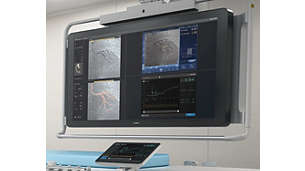iFR
Be confident in treatment and deferral decisions with Philips iFR.
Demonstrated results
1 in 4
Patients with angiographically successful PCI left the cath lab with residual ischemia (defined as iFR <0.90, residual DS < 50% in any treated lesion).3
68%
Relative reduction in clinical events at one year follow-up among patients achieving post-PCI iFR ≥ 0.95 (p-value=0.04).4
81.6%
Of the patients with residual ischemia were caused by an untreated angiographically inapparent physiologically focal stenosis (≤ 15 mm).3
$1024
On average saved with iFR compared to FFR, as found by iFR Swedeheart.5
Features

Only iFR has Co-registration for advanced physiologic guidance
iFR Co-registration is available on the new Philips IntraSight interventional applications platform and as an upgrade to the Core systems.
Map iFR values directly onto the angiogram so you can see which parts of a vessel are causing ischemia. With iFR Co-registration there is no need for hyperemic drugs. You can automatically co-register values in seconds onto the angiogram.

iFR Pullback technology7
• Provides beat-by-beat iFR pressure measurements across the entire vessel, artery-by-artery • Establishes the physiological significance of each vessel and/or individual lesion (focal or diffuse) • Provides a clear view of the functional gain
iFR Pullback technology reveals the physiologic profile of the entire vessel, so when you encounter diffuse disease or serial lesions you can make informed treatment decisions.
Image gallery
- Toggle view

World’s first solid core pressure guide wire¹¹
With an all new workhorse design, only Philips OmniWire pressure guide wire combines confidence in wire performance with proven iFR outcomes and iFR Co-registration, making it easy to benefit from physiology throughout the case.3,9-10
iFR technology is available on
-
IntraSight
The IntraSight Interventional Applications Workspace is where imaging, physiology, co-registration* and software all come together to help identify coronary and peripheral artery disease, and allow for more optimized treatment plans. IntraSight is built on a new foundational platform designed to meet the evolving needs of your lab today and tomorrow.
IGTDINTRSGHT -
SyncVision
The SyncVision precision guidance system is suitable with IntraSight and Core Integrated interventional platforms and streamlines lesion assessment, simplifies vessel sizing and enables precise therapy delivery all while integrating seamlessly in daily workflows in interventional suites of choice.
IGTDSYNC

Class IA recommendation
Only Philips iFR has a Class IA recommendation by the ACC/AHA/SCAI and ESC1,2
Documentation
- Resources
-
- Clinical articles
-
- Video assets
-
Footnotes
[1] Neumann, F-J et al. 2018 ESC/EACTS Guidelines on myocardial revascularization. European Heart Journal (2019) 40, 87–165. Philips medical devices should only be used by physicians and teams trained in interventional techniques, including training in the use of this device. Products subject to country availability. Please contact your local sales representative. ©2024 Koniklijke Philips N.V. All rights reserved. Trademarks are the property of Koninklijke Philips N.V. or their respective owners. Philips reserves the right to change product specifications without prior notification
[2] Lawton J. et al. 2021 ACC/AHA/SCAI Guideline for Coronary Artery Revascularization. JACC. 2022;79(2):e21-e129.
[3] Jeremias A et al. Blinded physiological assessment of residual ischemia after successful angiographic percutaneous coronary Intervention: The DEFINE PCI Study. JACC Cardiovasc Interv. 2019 Oct 28;12(20):1991-2001.
[4] Patel et al. 1-Year Outcomes of Blinded Physiological Assessment of Residual Ischemia After Successful PCI. J Am Coll Cardiol Intv 2022;15:52–6.
[5] Berntorp et al. Instantaneous wave-free ratio compared with fractional flow reserve in PCI: A cost-minimization analysis. Int J Cardiol 2021 1;344:54-59.
[6] Nijjer SS, et al. Pre-angioplasty instantaneous wave-free ratio pullback provides virtual intervention and predicts hemodynamic outcome for serial lesions and diffuse coronary re-angioplasty instantaneous wave-free ratio pullback provides virtual intervention and predicts hemodynamic outcome for serial lesions and diffuse coronary artery disease. JACC Cardiovasc Interv. 2014;7(12):1386-96.
[7] Co-registration operator's manual D001336104_A_300010660481
[8] Data on file at Philips Syncvision co-registration validation report D001370468_B
[9] Davies JE, et al., Use of the Instantaneous Wave-free Ratio or Fractional Flow Reserve in PCI. N Engl J Med. 2017 24-1834
[10] Gotberg M, et al. iFR-SWEDEHEART Investigators. Instantaneous Wave-free Ratio versus Fractional Flow Reserve to Guide PCI. N Engl J Med. 2017 May 11;376(19):1813-1823.
[11] Data on file at Philips D000410086_A, D000485394_A
Always read the label and follow the directions for use.


